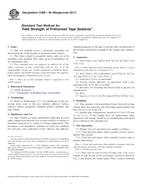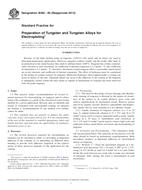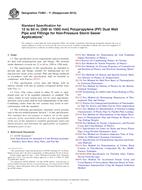1.1 This test method covers a procedure (Procedure A) for the determination of moisture absorption or desorption properties in the through-the-thickness direction for single-phase Fickian solid materials in flat or curved panel form. Also covered are procedures for conditioning test coupons prior to use in other test methods; either to equilibrium in a non-laboratory environment (Procedure B), to equilibrium in a standard laboratory atmosphere environment (Procedure C), or to an essentially moisture-free state (Procedure D). While intended primarily for laminated polymer matrix composite materials, these procedures are also applicable to other materials that satisfy the assumptions of 1.2.
1.2 The calculation of the through-the-thickness moisture diffusivity constant in Procedure A assumes a single-phase Fickian material with constant moisture absorption properties through the thickness of the specimen. The validity of the equations used in Procedure A for evaluating the moisture diffusivity constant in a material of previously unknown moisture absorption behavior is uncertain prior to the test, as the test results themselves determine if the material follows the single-phase Fickian diffusion model. A reinforced polymer matrix composite material tested below its glass-transition temperature typically meets this requirement, although two-phase matrices such as toughened epoxies may require a multi-phase moisture absorption model. While the test procedures themselves may be used for multi-phase materials, the calculations used to determine the moisture diffusivity constant in Procedure A are applicable only to single-phase materials. Other examples of materials and test conditions that may not meet the requirements are discussed in Section 6.
1.3 The evaluation by Procedure A of the moisture equilibrium content material property does not assume, and is therefore not limited to, single-phase Fickian diffusion behavior.
1.4 The procedures used by this test method may be performed, and the resulting data reduced, by suitable automatic equipment.
1.5 This test method is consistent with the recommendations of MIL-HDBK-17B (1), which describes the desirable attributes of a conditioning and moisture property determination procedure.
1.6 This standard does not purport to address all of the safety problems, if any, associated with its use. It is the responsibility of the user of this standard to establish appropriate safety and health practices and determine the applicability of regulatory limitations prior to use.
1.7 The values stated in either SI units or inch-pound units are to be regarded separately as standard. Within the text the inch-pound units are shown in brackets. The values stated in each system are not exact equivalents; therefore, each system must be used independently of the other. Combining values from the two systems may result in nonconformance with the standard.
Product Details
- Published:
- 03/01/2004
- Number of Pages:
- 13
- File Size:
- 1 file , 130 KB


